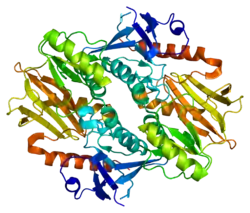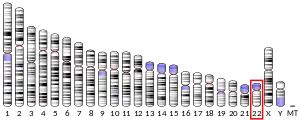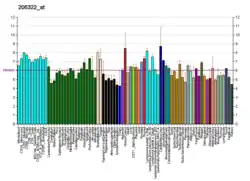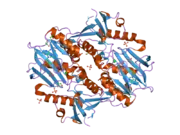| SYN3 | |||||||||||||||||||||||||||||||||||||||||||||||||||
|---|---|---|---|---|---|---|---|---|---|---|---|---|---|---|---|---|---|---|---|---|---|---|---|---|---|---|---|---|---|---|---|---|---|---|---|---|---|---|---|---|---|---|---|---|---|---|---|---|---|---|---|
 | |||||||||||||||||||||||||||||||||||||||||||||||||||
| |||||||||||||||||||||||||||||||||||||||||||||||||||
| Identifiers | |||||||||||||||||||||||||||||||||||||||||||||||||||
| Aliases | SYN3, synapsin III | ||||||||||||||||||||||||||||||||||||||||||||||||||
| External IDs | OMIM: 602705 MGI: 1351334 HomoloGene: 68320 GeneCards: SYN3 | ||||||||||||||||||||||||||||||||||||||||||||||||||
| |||||||||||||||||||||||||||||||||||||||||||||||||||
| |||||||||||||||||||||||||||||||||||||||||||||||||||
| |||||||||||||||||||||||||||||||||||||||||||||||||||
| |||||||||||||||||||||||||||||||||||||||||||||||||||
| |||||||||||||||||||||||||||||||||||||||||||||||||||
| Wikidata | |||||||||||||||||||||||||||||||||||||||||||||||||||
| |||||||||||||||||||||||||||||||||||||||||||||||||||
Synapsin-3 is a protein that in humans is encoded by the SYN3 gene.[5][6]
This gene is a member of the synapsin gene family. Synapsins encode neuronal phosphoproteins which associate with the cytoplasmic surface of synaptic vesicles. Family members are characterized by common protein domains, and they are implicated in synaptogenesis and the modulation of neurotransmitter release, suggesting a potential role in several neuropsychiatric diseases. The protein encoded by this gene shares the synapsin family domain model, with domains A, C, and E exhibiting the highest degree of conservation. The protein contains a unique domain J, located between domains C and E. Based on this gene's localization to 22q12.3, a possible schizophrenia susceptibility locus, and the established neurobiological roles of the synapsins, this family member may represent a candidate gene for schizophrenia. The TIMP3 gene is located within an intron of this gene and is transcribed in the opposite direction. Alternative splicing of this gene results in six transcript variants; however, only two variants have been fully described.[6]
References
- 1 2 3 GRCh38: Ensembl release 89: ENSG00000185666 - Ensembl, May 2017
- 1 2 3 GRCm38: Ensembl release 89: ENSMUSG00000059602 - Ensembl, May 2017
- ↑ "Human PubMed Reference:". National Center for Biotechnology Information, U.S. National Library of Medicine.
- ↑ "Mouse PubMed Reference:". National Center for Biotechnology Information, U.S. National Library of Medicine.
- ↑ Kao HT, Porton B, Czernik AJ, Feng J, Yiu G, Haring M, Benfenati F, Greengard P (May 1998). "A third member of the synapsin gene family". Proc Natl Acad Sci U S A. 95 (8): 4667–72. Bibcode:1998PNAS...95.4667K. doi:10.1073/pnas.95.8.4667. PMC 22548. PMID 9539796.
- 1 2 "Entrez Gene: SYN3 synapsin III".
Further reading
- Hosaka M, Südhof TC (1999). "Homo- and heterodimerization of synapsins". J. Biol. Chem. 274 (24): 16747–53. doi:10.1074/jbc.274.24.16747. PMID 10358015.
- Kao HT, Porton B, Hilfiker S, et al. (2000). "Molecular evolution of the synapsin gene family". J. Exp. Zool. 285 (4): 360–77. doi:10.1002/(SICI)1097-010X(19991215)285:4<360::AID-JEZ4>3.0.CO;2-3. PMID 10578110.
- Porton B, Kao HT, Greengard P (1999). "Characterization of transcripts from the synapsin III gene locus". J. Neurochem. 73 (6): 2266–71. doi:10.1046/j.1471-4159.1999.0732266.x. PMID 10582583. S2CID 35368177.
- Dunham I, Shimizu N, Roe BA, et al. (1999). "The DNA sequence of human chromosome 22" (PDF). Nature. 402 (6761): 489–95. Bibcode:1999Natur.402..489D. doi:10.1038/990031. PMID 10591208.
- Tsai MT, Hung CC, Tsai CY, et al. (2002). "Mutation analysis of synapsin III gene in schizophrenia". Am. J. Med. Genet. 114 (1): 79–83. doi:10.1002/ajmg.10116. PMID 11840510.
- Jaffrey SR, Benfenati F, Snowman AM, et al. (2002). "Neuronal nitric-oxide synthase localization mediated by a ternary complex with synapsin and CAPON". Proc. Natl. Acad. Sci. U.S.A. 99 (5): 3199–204. Bibcode:2002PNAS...99.3199J. doi:10.1073/pnas.261705799. PMC 122496. PMID 11867766.
- Strausberg RL, Feingold EA, Grouse LH, et al. (2003). "Generation and initial analysis of more than 15,000 full-length human and mouse cDNA sequences". Proc. Natl. Acad. Sci. U.S.A. 99 (26): 16899–903. Bibcode:2002PNAS...9916899M. doi:10.1073/pnas.242603899. PMC 139241. PMID 12477932.
- Porton B, Ferreira A, DeLisi LE, Kao HT (2004). "A rare polymorphism affects a mitogen-activated protein kinase site in synapsin III: possible relationship to schizophrenia". Biol. Psychiatry. 55 (2): 118–25. doi:10.1016/j.biopsych.2003.07.002. PMID 14732590. S2CID 20910529.
- Collins JE, Wright CL, Edwards CA, et al. (2005). "A genome annotation-driven approach to cloning the human ORFeome". Genome Biol. 5 (10): R84. doi:10.1186/gb-2004-5-10-r84. PMC 545604. PMID 15461802.
- Gerhard DS, Wagner L, Feingold EA, et al. (2004). "The status, quality, and expansion of the NIH full-length cDNA project: the Mammalian Gene Collection (MGC)". Genome Res. 14 (10B): 2121–7. doi:10.1101/gr.2596504. PMC 528928. PMID 15489334.
- Lachman HM, Stopkova P, Rafael MA, Saito T (2005). "Association of schizophrenia in African Americans to polymorphism in synapsin III gene". Psychiatr. Genet. 15 (2): 127–32. doi:10.1097/00041444-200506000-00009. PMID 15900227. S2CID 13481385.
- Lachman HM, Stopkova P, Papolos DF, et al. (2006). "Analysis of synapsin III-196 promoter mutation in schizophrenia and bipolar disorder". Neuropsychobiology. 53 (2): 57–62. doi:10.1159/000091720. PMID 16511335. S2CID 19172442.
- Makkar R, Gomez L, Wigg KG, et al. (2007). "The gene for synapsin III and attention-deficit hyperactivity disorder". Psychiatr. Genet. 17 (2): 109–12. doi:10.1097/YPG.0b013e328012a0c6. PMID 17413450. S2CID 28799136.





